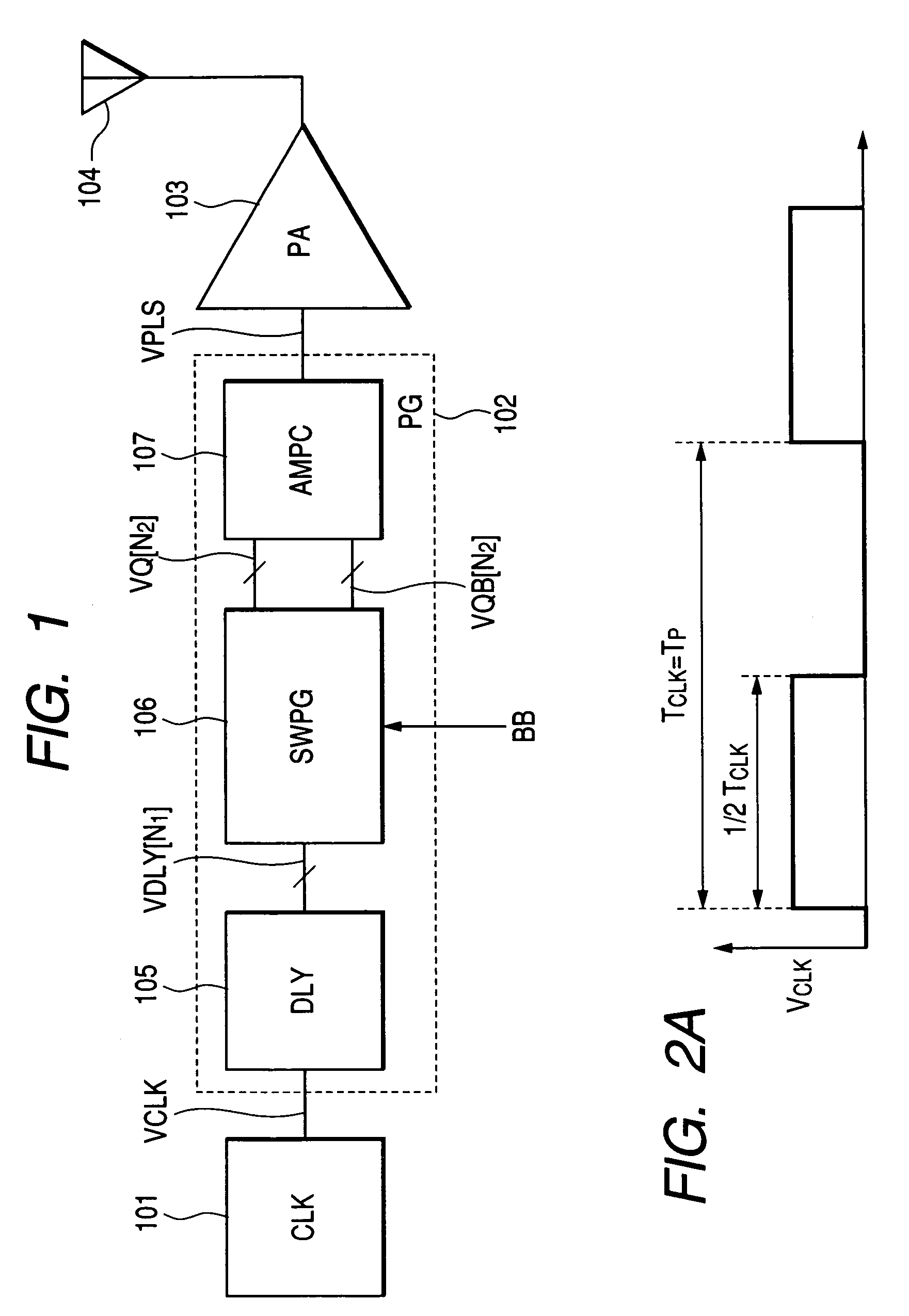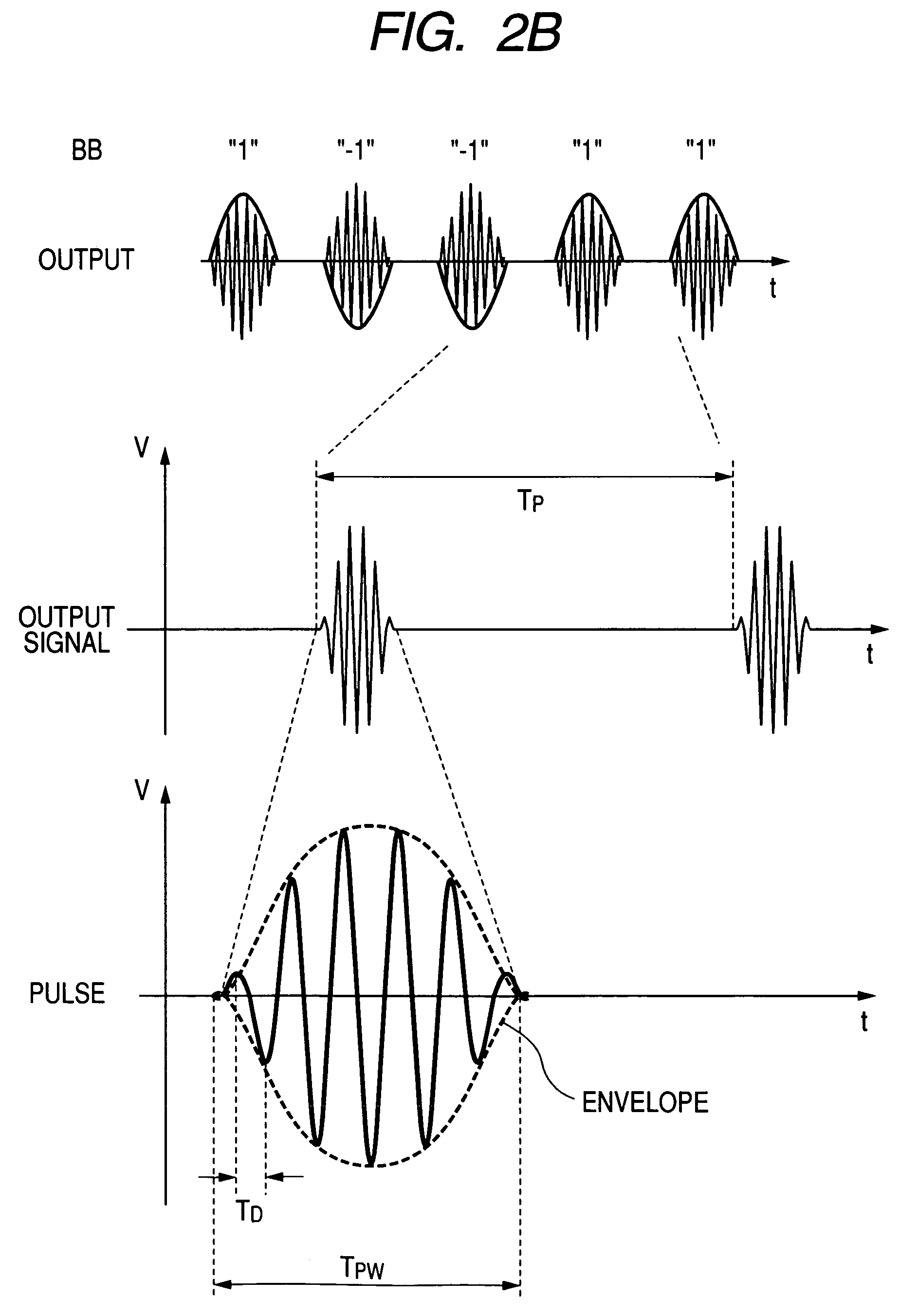Pulse generator and the transmitter with a pulse generator
a pulse generator and transmitter technology, applied in pulse train generators, pulse techniques, baseband system details, etc., can solve the problems of increasing power consumption, affecting so as to reduce the effect of reducing the accuracy of output signal waveforms
- Summary
- Abstract
- Description
- Claims
- Application Information
AI Technical Summary
Benefits of technology
Problems solved by technology
Method used
Image
Examples
first embodiment
[0055]FIG. 4 shows details of the delay circuit 105 of a pulse generator that is a first embodiment of this invention. The delay circuit 105 consists of a plurality of delay elements provided in series, and has a function of delaying an inputted signal over a plurality of stages, each stage delaying the signal by a delay time Td. In the following example, an example whose delay circuits are of nine stages is shown.
[0056]In order to improve the accuracy of delay, it is preferable for the delay circuit 105 to adopt a DDL (Delay Locked Loop) consisting of: a delay array 6010 composed of delay elements 601 each of which is capable of controlling a delay time, such as an inverter, being connected to one another and arranged in a plurality of stages; a phase comparator (PD) 6012 that compares phases between the input clock and an output of the last-stage delay element and generates a square wave having a pulse width equal to a time of the phase difference; and a charge pump (CP) 6014 for ...
second embodiment
[0083]A second embodiment of this invention will be described using FIGS. 13-16. In the second embodiment, the first embodiment shown in FIG. 1 is altered so as to have a differential configuration, and the load of the amplitude control unit is altered to a combination of a resistor and a capacitor.
[0084]As shown in FIG. 13, a pulse generator is constructed with the delay circuit 105 for generating a plurality of signals having different delay times, two square-wave pulse generation circuits 1106 each of which controls an output pattern of a plurality of square wave pulses each having a pulse width comparable to its differential delay based on the baseband signal (BB) and outputs the pulses; and the amplitude control unit 107 for generating waveforms whose amplitudes are different depending on an input of the square wave pulse. A transmitter is constructed with the clock generator 101, the pulse generator 102, the power amplifier (PA) 103, and the antenna 104.
[0085]Next, a concrete ...
third embodiment
[0096]A third embodiment is an example in which the current sources in the amplitude control unit in the first embodiment are altered to voltage sources.
[0097]FIG. 17 shows a pulse generator according to a third embodiment this invention. The pulse generator of FIG. 17 is the amplitude alteration unit of the first embodiment shown in FIG. 4 whose current source is altered to a voltage source. As shown in FIG. 17, the pulse generator consist of the clock generator 101, the delay circuit 105, a square-wave pulse generation circuit 1506, and an amplitude control unit 1507 made up of voltage sources 1002 and MOS switches 1001. In the following example, an example whose delay circuits are of six stages is shown.
[0098]An output of the clock generator 101 is fed to the delay circuit 105, an output of the delay circuit 105 and the baseband signal are fed to the square-wave pulse generation circuit 1506, an output of the square-wave pulse generation circuit 1506 is fed to the amplitude contr...
PUM
 Login to View More
Login to View More Abstract
Description
Claims
Application Information
 Login to View More
Login to View More - R&D
- Intellectual Property
- Life Sciences
- Materials
- Tech Scout
- Unparalleled Data Quality
- Higher Quality Content
- 60% Fewer Hallucinations
Browse by: Latest US Patents, China's latest patents, Technical Efficacy Thesaurus, Application Domain, Technology Topic, Popular Technical Reports.
© 2025 PatSnap. All rights reserved.Legal|Privacy policy|Modern Slavery Act Transparency Statement|Sitemap|About US| Contact US: help@patsnap.com



